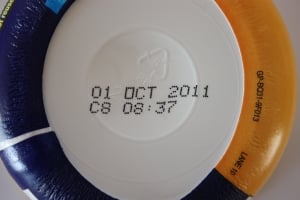
There are many reasons to mark plastic, but with the increasing popularity of plastic packaging, for everything from milk to motor oil, it’s no surprise that the most common reason for marking plastic is to apply an expiration date to a food or beverage item.
So, what options do you have for printing expiration dates on plastic?
Considerations for Printing Expiration Dates on Plastic

The first thing to consider when marking an expiration date on thin plastic is the type of mark you want to create.
There are a lot of ways to permanently mark a material (laser engraving, hot stamping, markers) but not all of them are suitable for the types of thin plastic most packaging is made of.
Hot stamping, for instance, would be a terrible choice for marking thin plastic because it would be nearly impossible to prevent the marking tool from burning right through the plastic.
Just to clarify, it is definitely possible to hot stamp plastic; however, it has to be thick plastic, like that used in hosing, but by and large, packaging that requires an expiration date is typically too thin for this marking method.
Industrial paint markers might seem like a viable solution; they create a permanent mark without the use of heat. Markers are best suited to low-volume applications, however, and most applications where an expiration date is required are medium to high volume.
If the application is low enough volume, you could use a marker to add an expiration date by hand to each piece of plastic packaging. For most, however, this would be a grossly inefficient marking method.
The last big consideration has to do with the type of mark you will be making, the expiration date. Because the mark you’ll need to create isn’t static (the same mark over and over) the marking method must allow for easy change.
When all of the specifications and material considerations are taken into account, there are two main methods by which an expiration date is typically added to plastic: rubber stamps with ink and inkjet printers.
Best Methods for Printing Expiration Dates on Plastic
 Permanent ink stamps are one of the most common ways to mark expiration dates on plastic because they are inexpensive, flexible, durable, and portable. Ink stamps that are used for marking expiration dates typically consist of several bands printed with either numbers or a combination of numbers and letters to represent the date.
Permanent ink stamps are one of the most common ways to mark expiration dates on plastic because they are inexpensive, flexible, durable, and portable. Ink stamps that are used for marking expiration dates typically consist of several bands printed with either numbers or a combination of numbers and letters to represent the date.
For instance, a two-band stamp could be used to mark month and day with the first band printed with 1-12 and the second band printed with 1-31. Custom wrap bands are also available for repetitive phrases such as BEST BY, EXP, and LOT#. Our non-porous inks are specifically designed to work on materials like plastic.
 Another option for marking on plastic is an ink jet printer. Printers are capable of printing a range of character sizes and offer varying degrees of functionality and portability.
Another option for marking on plastic is an ink jet printer. Printers are capable of printing a range of character sizes and offer varying degrees of functionality and portability.
Typically, however, a printer is a good solution for printing an expiration date on plastic if more information also needs to be printed. Printers are often used when printing multiple lines of text is required, or for printing both a bar code and an expiration date in one pass, saving time and creating a permanent mark on the plastic.
The best way to learn how to print expiration dates on plastic is to refer to your specific printer’s owner's manual. In general, however, the necessary information is entered into the printer, the printer is passed over the packaging, and the information is marked onto the plastic.
Learn More
Contact us for more information about printing expiration dates on plastic.




